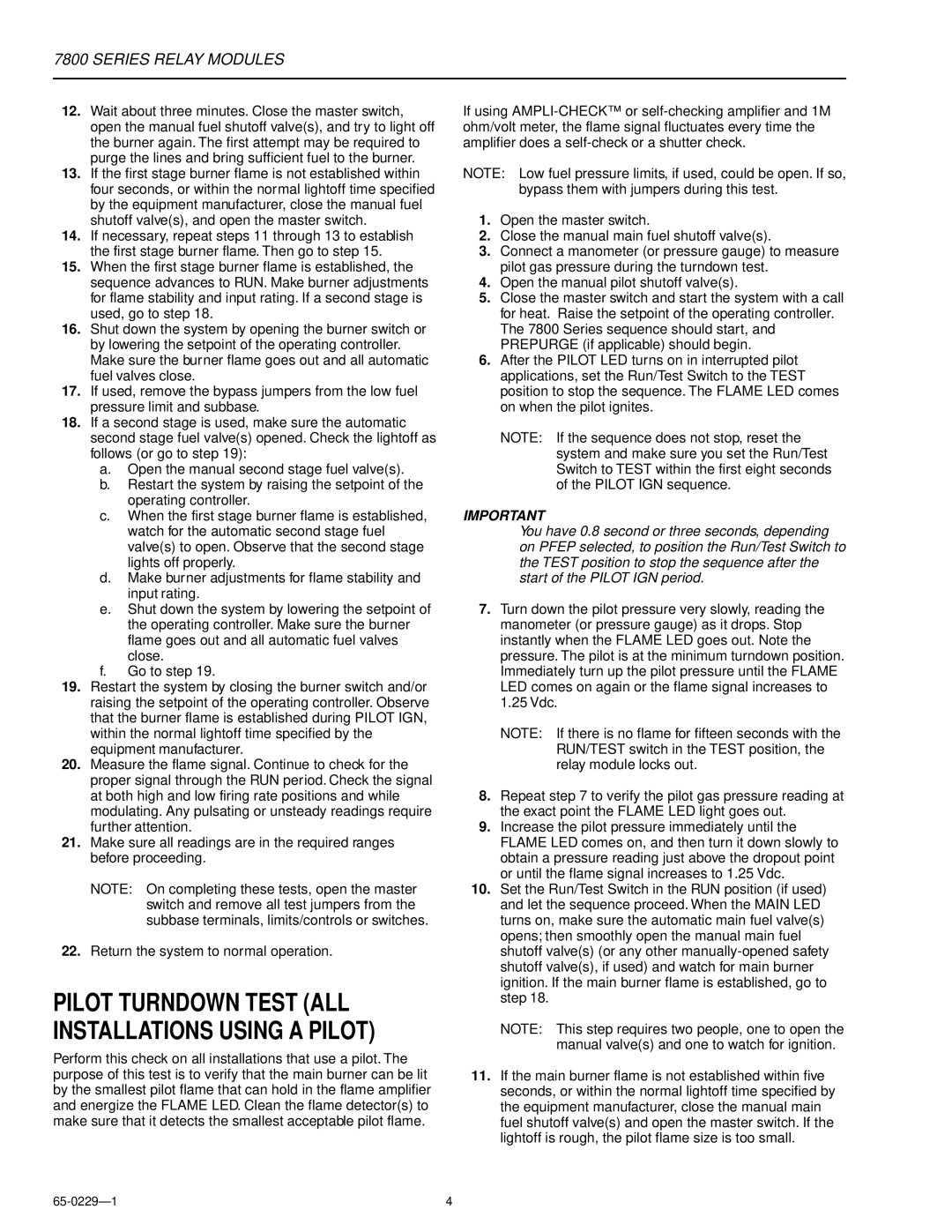7800 SERIES RELAY MODULES
12.Wait about three minutes. Close the master switch, open the manual fuel shutoff valve(s), and try to light off the burner again. The first attempt may be required to purge the lines and bring sufficient fuel to the burner.
13.If the first stage burner flame is not established within four seconds, or within the normal lightoff time specified by the equipment manufacturer, close the manual fuel shutoff valve(s), and open the master switch.
14.If necessary, repeat steps 11 through 13 to establish the first stage burner flame. Then go to step 15.
15.When the first stage burner flame is established, the sequence advances to RUN. Make burner adjustments for flame stability and input rating. If a second stage is used, go to step 18.
16.Shut down the system by opening the burner switch or by lowering the setpoint of the operating controller. Make sure the burner flame goes out and all automatic fuel valves close.
17.If used, remove the bypass jumpers from the low fuel pressure limit and subbase.
18.If a second stage is used, make sure the automatic second stage fuel valve(s) opened. Check the lightoff as follows (or go to step 19):
a.Open the manual second stage fuel valve(s).
b.Restart the system by raising the setpoint of the operating controller.
c.When the first stage burner flame is established, watch for the automatic second stage fuel valve(s) to open. Observe that the second stage lights off properly.
d.Make burner adjustments for flame stability and input rating.
e.Shut down the system by lowering the setpoint of the operating controller. Make sure the burner flame goes out and all automatic fuel valves close.
f.Go to step 19.
19.Restart the system by closing the burner switch and/or raising the setpoint of the operating controller. Observe that the burner flame is established during PILOT IGN, within the normal lightoff time specified by the equipment manufacturer.
20.Measure the flame signal. Continue to check for the proper signal through the RUN period. Check the signal at both high and low firing rate positions and while modulating. Any pulsating or unsteady readings require further attention.
21.Make sure all readings are in the required ranges before proceeding.
NOTE: On completing these tests, open the master switch and remove all test jumpers from the subbase terminals, limits/controls or switches.
22.Return the system to normal operation.
PILOT TURNDOWN TEST (ALL INSTALLATIONS USING A PILOT)
Perform this check on all installations that use a pilot. The purpose of this test is to verify that the main burner can be lit by the smallest pilot flame that can hold in the flame amplifier and energize the FLAME LED. Clean the flame detector(s) to make sure that it detects the smallest acceptable pilot flame.
If using
NOTE: Low fuel pressure limits, if used, could be open. If so, bypass them with jumpers during this test.
1.Open the master switch.
2.Close the manual main fuel shutoff valve(s).
3.Connect a manometer (or pressure gauge) to measure pilot gas pressure during the turndown test.
4.Open the manual pilot shutoff valve(s).
5.Close the master switch and start the system with a call for heat. Raise the setpoint of the operating controller. The 7800 Series sequence should start, and PREPURGE (if applicable) should begin.
6.After the PILOT LED turns on in interrupted pilot applications, set the Run/Test Switch to the TEST position to stop the sequence. The FLAME LED comes on when the pilot ignites.
NOTE: If the sequence does not stop, reset the system and make sure you set the Run/Test Switch to TEST within the first eight seconds of the PILOT IGN sequence.
IMPORTANT
You have 0.8 second or three seconds, depending on PFEP selected, to position the Run/Test Switch to the TEST position to stop the sequence after the start of the PILOT IGN period.
7.Turn down the pilot pressure very slowly, reading the manometer (or pressure gauge) as it drops. Stop instantly when the FLAME LED goes out. Note the pressure. The pilot is at the minimum turndown position. Immediately turn up the pilot pressure until the FLAME LED comes on again or the flame signal increases to 1.25 Vdc.
NOTE: If there is no flame for fifteen seconds with the RUN/TEST switch in the TEST position, the relay module locks out.
8.Repeat step 7 to verify the pilot gas pressure reading at the exact point the FLAME LED light goes out.
9.Increase the pilot pressure immediately until the FLAME LED comes on, and then turn it down slowly to obtain a pressure reading just above the dropout point or until the flame signal increases to 1.25 Vdc.
10.Set the Run/Test Switch in the RUN position (if used) and let the sequence proceed. When the MAIN LED turns on, make sure the automatic main fuel valve(s) opens; then smoothly open the manual main fuel shutoff valve(s) (or any other
NOTE: This step requires two people, one to open the manual valve(s) and one to watch for ignition.
11.If the main burner flame is not established within five seconds, or within the normal lightoff time specified by the equipment manufacturer, close the manual main fuel shutoff valve(s) and open the master switch. If the lightoff is rough, the pilot flame size is too small.
4 |
